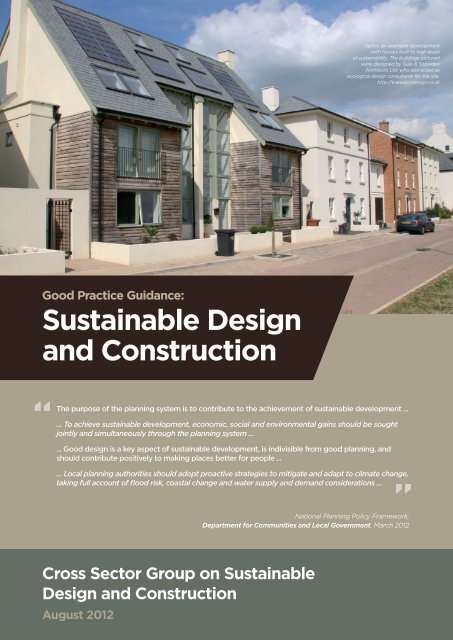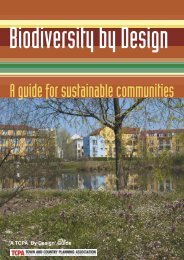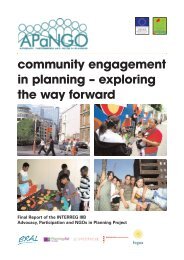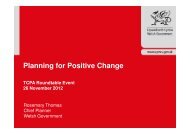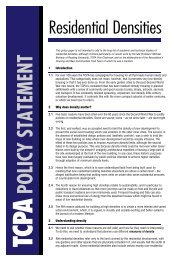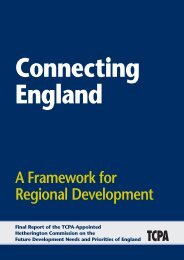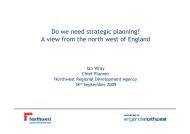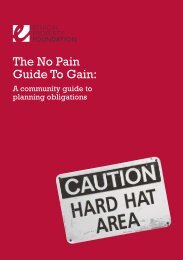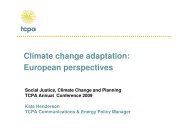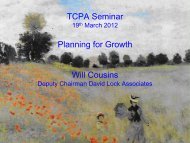Sustainable Design and Construction - Breeam
Sustainable Design and Construction - Breeam
Sustainable Design and Construction - Breeam
- No tags were found...
Create successful ePaper yourself
Turn your PDF publications into a flip-book with our unique Google optimized e-Paper software.
Upton, an exemplar developmentwith houses built to high levelsof sustainability. The buildings picturedwere designed by Gale & SnowdenArchitects Ltd, who also acted asecological design consultants for the site.http://www.ecodesign.co.ukGood Practice Guidance:<strong>Sustainable</strong> <strong>Design</strong><strong>and</strong> <strong>Construction</strong>The purpose of the planning system is to contribute to the achievement of sustainable development ...... To achieve sustainable development, economic, social <strong>and</strong> environmental gains should be soughtjointly <strong>and</strong> simultaneously through the planning system ...... Good design is a key aspect of sustainable development, is indivisible from good planning, <strong>and</strong>should contribute positively to making places better for people ...... Local planning authorities should adopt proactive strategies to mitigate <strong>and</strong> adapt to climate change,taking full account of flood risk, coastal change <strong>and</strong> water supply <strong>and</strong> dem<strong>and</strong> considerations ...National Planning Policy Framework,Department for Communities <strong>and</strong> Local Government, March 2012Cross Sector Group on <strong>Sustainable</strong><strong>Design</strong> <strong>and</strong> <strong>Construction</strong>August 2012
ContentsIntroduction 03Background 04The role of planning, <strong>and</strong> its relationto Building Regulations 05Formulating planning policies onsustainable design <strong>and</strong> construction 06Justifying local requirements:evidence <strong>and</strong> viability 06Examples of local plan policies 07Development management 08Annex 1 – Example policies on sustainable design <strong>and</strong> construction(including relevant extracts from Inspectors’ reports) 09Annex 2 – Example conditions on sustainable design <strong>and</strong> construction 14Annex 3 – Comparison of sustainable construction st<strong>and</strong>ards 14Annex 4 – Organisations contributing to <strong>and</strong> supporting this guidance 15Images from top:The Green, the University of Bradford’s BREEAM Outst<strong>and</strong>ing sustainable student villagehttp://www.breeam.org/page.jsp?id=465BREEAM Outst<strong>and</strong>ing Houghton Primary Care Centre http://www.breeam.org/page.jsp?id=437BRE’s Innovation Park provides a series of exemplar sustainable housing developments <strong>and</strong> ashowcase for innovative <strong>and</strong> sustainable products http://www.bre.co.uk/innovationpark
Good Practice Guidance: <strong>Sustainable</strong> <strong>Design</strong> <strong>and</strong> <strong>Construction</strong> 03Good Practice Guidance:<strong>Sustainable</strong> <strong>Design</strong> <strong>and</strong> <strong>Construction</strong>Introduction1 This guidance has been produced for use by localplanning authorities in Engl<strong>and</strong>, together with l<strong>and</strong>owners,developers, businesses, town <strong>and</strong> parish councils,community groups <strong>and</strong> others.2 Its aim is to assist plan-making <strong>and</strong> developmentmanagement in support of local planning authorities’statutory duty to contribute to the achievement ofsustainable development, of which sustainable design <strong>and</strong>construction is an integral part.3 While the guidance is not a statutory document, itnevertheless has considerable support <strong>and</strong> can beexpected to be accorded appropriate weight in both planmaking<strong>and</strong> development management. The approachesset out in the guidance have been designed to supportthe policy in the National Planning Policy Framework(NPPF) <strong>and</strong> other relevant government statutes <strong>and</strong>guidance.5 The guidance has been developed following anindependently chaired event held at BRE Watford inDecember 2011 attended by representatives of a range ofdeveloper, environmental, government, community <strong>and</strong>professional interests. There was a consensus that therewas a need for good practice guidance on sustainabledesign <strong>and</strong> construction to underpin the NPPF, not leastto avoid a proliferation of local sustainability st<strong>and</strong>ards<strong>and</strong> assessment methods that could confuse users of theplanning system.6 The guidance has been produced by collaborativeworking between the parties involved, <strong>and</strong> is supportedby the organisations listed at the end.4 The guidance cannot cover all planning policy issues thathave a bearing on sustainable design <strong>and</strong> construction.Some of this material, including flood risk, is dealt within the Technical Guidance to the National PlanningPolicy Framework. The related cross-sector guideson climate change <strong>and</strong> green infrastructure <strong>and</strong>biodiversity 1 provide more detail on planning policies <strong>and</strong>implementation in relation to those issues.1 The L<strong>and</strong>scape Institute has also published recent guidance on green infrastructure.climate change http://www.tcpa.org.uk/data/files/PCC_Guide_April_2012.pdfgreen infrastructure <strong>and</strong> biodiversity http://www.tcpa.org.uk/data/files/TCPA_TWT_GI-Biodiversity-Guide.pdfrecent guidance http://www.l<strong>and</strong>scapeinstitute.org/policy/GreenInfrastructure.php
04 Good Practice Guidance: <strong>Sustainable</strong> <strong>Design</strong> <strong>and</strong> <strong>Construction</strong>Background7 The NPPF states that “The purpose of the planning systemis to contribute to sustainable development”. <strong>Sustainable</strong>development is key to tackling the linked challengesof climate change, resource use, economic prosperity<strong>and</strong> social well-being, <strong>and</strong> cannot be achieved withoutsustainable buildings. This note provides guidance on howthe planning system can encourage sustainable design <strong>and</strong>construction as part of this.8 The note complements “Planning for climate change”published by the Planning <strong>and</strong> Climate Change Coalitionin April 2012. The Climate Change Act 2008 contains astatutory target of securing a reduction in carbon dioxidelevels of 80% below 1990 levels by 2050, with an interimtarget of 34% reduction by 2020. In 2011 the Departmentof Energy <strong>and</strong> Climate Change <strong>and</strong> Local GovernmentAssociation signed a memor<strong>and</strong>um of underst<strong>and</strong>ing,outlining their shared commitment to helping to securethis reduction.9 Half of all of the country’s carbon emissions come fromthe energy used in constructing, occupying <strong>and</strong> operatingbuildings. A high st<strong>and</strong>ard of construction is therefore vitalto achieving these statutory targets.10 <strong>Sustainable</strong> design <strong>and</strong> construction is concerned withimplementing sustainable development at the scale ofindividual sites <strong>and</strong> buildings. It takes account of theresources used in construction, <strong>and</strong> of the environmental,social <strong>and</strong> economic impacts of the construction processitself <strong>and</strong> of how buildings are designed <strong>and</strong> used. Thus,while consideration of energy <strong>and</strong> carbon impacts is animportant element, sustainable design <strong>and</strong> constructiongoes wider than this. In summary, it seeks to: minimisethe use of resources (including energy <strong>and</strong> water); ensurethat the built environment mitigates <strong>and</strong> is resilient tothe impact of climate change; protect <strong>and</strong> enhancebiodiversity <strong>and</strong> green infrastructure; provide buildings<strong>and</strong> spaces that are pleasant <strong>and</strong> healthy for occupiers <strong>and</strong>users; ensure the sustainable sourcing of materials; <strong>and</strong>minimise waste.11 <strong>Sustainable</strong> design <strong>and</strong> construction is of majorimportance to the UK economy. The Government hasstated that the Green Deal will trigger £14billion ofinvestment to 2022 <strong>and</strong> support at least 65,000 insulation<strong>and</strong> construction jobs by 2015 2 . The export potential of thesector is demonstrated by the fact that UK companies areheavily involved in helping rapidly growing economies suchas China <strong>and</strong> Brazil with the development of innovationparks <strong>and</strong> sustainable construction technologies.12 Studies commissioned by CLG 3 indicate that as sustainableconstruction becomes more widely adopted the supplychain responds <strong>and</strong> costs are driven down.13 The National Planning Policy Framework seeks to promotethe role of the planning system in achieving sustainabledevelopment. A key element of this is the preparation oflocal plans which ensure that development is located inthe most sustainable locations, taking account of issuessuch as minimising the need to travel <strong>and</strong> access to publictransport, water supply, <strong>and</strong> flood risk. Once the locationhas been chosen, achieving sustainable developmentrequires masterplanning to be carried out in such a way asto make best use of a site’s characteristics <strong>and</strong> topography.14 Masterplanning should also be undertaken in such a way asto optimise the sustainability of a development as a whole,taking account of wider infrastructure <strong>and</strong> other issues.15 Developers <strong>and</strong> planners should be aware of thedifferences in the embodied impacts <strong>and</strong> the whole lifecost of building materials. This should be one of the factorstaken into account by developers when deciding betweendifferent approaches to development, <strong>and</strong> indeed betweenrefurbishment <strong>and</strong> redevelopment.16 While sustainable design <strong>and</strong> construction of newbuildings cannot make development acceptable on l<strong>and</strong>in an unsustainable location, they represent one elementof making settlements more sustainable. The contents ofthis guidance cover the encouragement of high st<strong>and</strong>ardsof site <strong>and</strong> building design <strong>and</strong> sustainable constructionpractice, after development l<strong>and</strong> has been allocatedthrough the local plan process. As the NPPF notes,“securing high quality <strong>and</strong> inclusive design goes beyondaesthetic considerations”. Subject to certain provisos, itstates that local planning authorities “should not refuseplanning permission for buildings or infrastructure whichpromote high levels of sustainability”.17 The Government is seeking to encourage owners ofexisting buildings to make them more energy efficientthrough programmes such as the Green Deal. It alsorecognises the importance of sustainable construction inits Housing Strategy, which acknowledges the role thatthe Code for <strong>Sustainable</strong> Homes can play. The strategyemphasises the Government’s commitment to improvingthe design <strong>and</strong> sustainability of housing in ways which givecommunities a say. This guidance aims to help implementthis commitment.2 (http://www.decc.gov.uk/en/content/cms/news/aes_2011/aes_2011.aspx)3 (http://www.communities.gov.uk/documents/planning<strong>and</strong>building/pdf/1972728.pdf)Planning for climate change http://www.tcpa.org.uk/data/files/PCC_Guide_April_2012.pdfGreen Deal http://www.decc.gov.uk/en/content/cms/tackling/green_deal/green_deal.aspxHousing Strategy http://www.communities.gov.uk/documents/housing/pdf/2033676.pdfCode for <strong>Sustainable</strong> Homes http://www.communities.gov.uk/planning<strong>and</strong>building/sustainability/codesustainablehomes/
Good Practice Guidance: <strong>Sustainable</strong> <strong>Design</strong> <strong>and</strong> <strong>Construction</strong> 05The role of planning, <strong>and</strong> its relationto Building Regulations18 Local <strong>and</strong> neighbourhood plans set the context for newdevelopment. They contain policies which outline thelocal planning authority’s objectives for its area, the mainlocations for development <strong>and</strong> the key criteria againstwhich development proposals will be considered.19 Planning has an important role in encouraging <strong>and</strong>facilitating buildings that meet high st<strong>and</strong>ards ofsustainability, in support of its statutory objective tocontribute to the achievement of sustainable development.The NPPF states that local planning authorities should planfor new development in locations <strong>and</strong> ways which reducegreenhouse gas emissions <strong>and</strong> actively support energyefficiency improvements to existing buildings.20 The Building Regulations set minimum st<strong>and</strong>ards inrelation to a number of sustainability issues, such asenergy efficiency <strong>and</strong> water consumption, as well asmatters such as structural soundness. For housing, theGovernment has adopted the Code for <strong>Sustainable</strong> Homesas a way of signposting the long-term direction of travelon sustainable design <strong>and</strong> construction. The GovernmentownedCode encourages a voluntary progression beyondminimum st<strong>and</strong>ards <strong>and</strong> drives innovation <strong>and</strong> change inthe construction industry. There are similar widely usedprivate sector assessment methods for non-domesticbuildings 4 . It is worth noting that some st<strong>and</strong>ards providefixed ratings that do not change significantly over time,while others are routinely updated. This can be importantwhen deciding what level to specify in planning policy.See annex 3 for more details.21 Technology, materials <strong>and</strong> the Building Regulationsregime will continue to evolve in the future. There will besituations where it could be appropriate for local planningauthorities to anticipate levels of building sustainability inadvance of those set out nationally. These could include,for example, where:n there are clear opportunities for significant use ofdecentralised <strong>and</strong> renewable or low-carbon energy ora need to safeguard their potential future use; orn local circumstances, such as high water stress, meanthat development without high st<strong>and</strong>ards would beunacceptable for its proposed location; orn local evidence shows that the impacts of climatechange will require adaptive measures in somebuildings <strong>and</strong> homes.22 It is important to recognise that st<strong>and</strong>ards such as theCode for <strong>Sustainable</strong> Homes, while taking account of theBuilding Regulations, cover a significantly wider range ofsustainability issues than is covered by regulation. Parts G<strong>and</strong> L of the Building Regulations address water efficiency<strong>and</strong> energy use respectively. The Code for <strong>Sustainable</strong>Homes incorporates these, <strong>and</strong> in addition addresses otherimportant sustainability issues such as materials, waste,health <strong>and</strong> well-being, ecology, <strong>and</strong> management of boththe construction process <strong>and</strong> the completed building.4 BREEAM is the most frequently used assessment <strong>and</strong> certification scheme for non-residential new buildings in Engl<strong>and</strong>, <strong>and</strong> is also widely usedinternationally. Other assessment schemes for buildings include SKA, the US-based LEED <strong>and</strong> Australian GreenStar. CEEQUAL is an assessmentmethodology for civil engineering projects. Further details of these schemes are given in annex 3.
Good Practice Guidance: <strong>Sustainable</strong> <strong>Design</strong> <strong>and</strong> <strong>Construction</strong> 0731 Policy requirements on sustainable construction shouldbe proportionate to the type of development <strong>and</strong> shouldnot unreasonably threaten the viability of developmentwhich otherwise accords with local plan policy. Inparticular, flexibility may be necessary on refurbishmentprojects where it may not be possible to meet the sameperformance levels as new build policy requirements.32 Planning authorities should ensure that what is proposedis viable, having regard to the need to continue to improvest<strong>and</strong>ards, the overall costs of bringing sites to themarket (including the costs of any necessary supportinginfrastructure) <strong>and</strong> the need to avoid any adverse impacton the development needs of communities. Developmentproposals should provide competitive returns todevelopers <strong>and</strong> l<strong>and</strong>owners. Proposals should not resultin requirements for public services or infrastructure whichare unaffordable, or are otherwise unsustainable in thelong term, for example because they are not resilient toclimate change.33 At the same time, authorities should recognise thatdevelopment viability can vary substantially bothover time <strong>and</strong> from one scheme to another. One ofthe important aims of schemes such as the Code for<strong>Sustainable</strong> Homes is to drive change in the supply chain<strong>and</strong> thereby to reduce costs. For example, CLG researchindicates that in the three years to August 2011 the extracosts of building to Code level 3 fell by approximatelythree quarters.34 Local plans should highlight the advantages ofconsidering sustainability issues as early as possible inthe development process. This can help to achieve moresustainable outcomes <strong>and</strong> to reduce overall costs.35 In considering the carbon compliance (on-site carbontarget for buildings), local planning authorities shouldtake account of current Government policy on achievingzero carbon performance. For new housing thedeveloping policy seeks to establish realistic limits forcarbon compliance, <strong>and</strong> allows for the full zero carbonst<strong>and</strong>ard to be achieved through the use of “allowablesolutions” - envisaged as mainly near-site or off-sitecarbon-saving projects which compensate for carbonemissions reductions that are difficult to achieve onsite. The Zero Carbon Hub has proposed a deliveryframework for allowable solutions. The Governmenthas yet to make a detailed policy announcement onthe delivery structure <strong>and</strong> scope of allowable solutions.Some local authorities are already exploring the use ofcarbon off-set funds <strong>and</strong> community energy funds asa way of delivering the concept of allowable solutionsin their areas. For housing, zero carbon requirements(carbon compliance coupled with allowable solutions)will be driven into mainstream new homes by BuildingRegulations (Approved Document L1A, 2016). A similarmechanism is expected to be developed for nondomesticbuildings <strong>and</strong> introduced in 2019.36 Some advice on testing the viability of local plans iscontained in the June 2012 report of the Local HousingDelivery Group <strong>and</strong> the August 2012 guidance from theRoyal Institution of Chartered Surveyors.Examples of local plan policies37 This guidance emphasises the importance of specificlocal evidence <strong>and</strong> assessment in developing local planpolicies. For this reason, it does not seek to promotemodel policies, as what is applicable in one part of thecountry may be inappropriate in another.38 However, local planning authorities may find it helpful toconsider experience elsewhere when developing theirown policies, provided they recognise that this is not asubstitute for local evidence. Annex 1 contains examplesof such policies.39 There are further details, including examples of adoptedlocal plan policies on sustainable design <strong>and</strong> construction,the type of evidence required to substantiate requiringparticular levels of conformity, <strong>and</strong> experience of testingthese at examination, on the BREEAM website.40 Further details of the Code for <strong>Sustainable</strong> Homes can befound in the Technical Guide 2010.CLG research http://www.communities.gov.uk/documents/planning<strong>and</strong>building/pdf/1972728.pdfZero Carbon Hub http://www.zerocarbonhub.orgReport of the Local Housing Delivery Group http://www.nhbc.co.uk/News<strong>and</strong>Comment/Documents/filedownload,47339,en.pdfGuidance from the Royal Institution of Chartered Surveyors http://www.rics.org/site/download_feed.aspx?fileID=12271&fileExtension=PDFBREEAM website http://www.breeam.org/page.jsp?id=268Technical Guide 2010 http://www.planningportal.gov.uk/uploads/code_for_sustainable_homes_techguide.pdf
08 Good Practice Guidance: <strong>Sustainable</strong> <strong>Design</strong> <strong>and</strong> <strong>Construction</strong>Development management41 Once policies on issues such as sustainable buildingst<strong>and</strong>ards or decentralised energy supply have beenadopted within a local plan or neighbourhood plan,development will be expected to comply with thepolicies, in accordance with the principle of theplan-led system. If a developer considers that thereare reasons why on a particular site such policiesshould not be complied with, for example due toexceptional costs of site reclamation, it would be forthe developer to make the case.42 Discussion <strong>and</strong> consideration of sustainable design<strong>and</strong> construction issues should take place at theearliest possible stage in the development process.This will provide the greatest opportunities for awell-designed <strong>and</strong> constructed development <strong>and</strong> atthe same time enable costs to be minimised. Thereis evidence that highly sustainable buildings can beproduced at little or no additional cost 5 , providedsustainability is designed in from the outset.44 Planning conditions should normally be related toidentifiable stages in the assessment process. Forexample, the Planning Inspectorate recommend acondition which prevents occupation of dwellingsbuilt to a specified level of the Code for <strong>Sustainable</strong>Homes until a post-construction certificate has beenprovided to the local planning authority (see Annex2). In all cases local planning authorities shouldsatisfy themselves that any condition is appropriateto the particular circumstances of the proposeddevelopment <strong>and</strong> local area, <strong>and</strong> may choose toapply development management principles flexibly tofacilitate rather than frustrate desirable development.Conditions should also comply with the longestablishedtests that they should be necessary;relevant to planning; relevant to the development tobe permitted; enforceable; precise; <strong>and</strong> reasonablein all other respects. The BREEAM website containsexamples both of conditions <strong>and</strong> of appeal decisionsrelating to sustainable design <strong>and</strong> construction.43 Local planning authorities <strong>and</strong> developers shouldtherefore consider sustainable construction issuesin pre-application discussions. Where a sustainableconstruction assessment of a proposed developmentwill be required, developers are advised to engage anassessor at the earliest possible stage as this is likelyto provide the best balance between maximisingthe sustainability potential of the development <strong>and</strong>minimising costs. The achievement of meeting thenecessary policy requirements should be capturedwithin a sustainability statement, which can formpart of the design <strong>and</strong> access statement. The needfor such a statement should be discussed at the preapplicationstage.5 http://www.bre.co.uk/page.jsp?id=1809BREEAM website http://www.breeam.org/page.jsp?id=268
Good Practice Guidance: <strong>Sustainable</strong> <strong>Design</strong> <strong>and</strong> <strong>Construction</strong> 11Inspector’s report (extract) 20 September 2011Pursuing sustainable construction methods <strong>and</strong> low carbon energy sources59 The borough is prone to water stress which is likelyto be adversely affected by climate change. Theborough’s industrial <strong>and</strong> commercial uses generate highemissions of CO2 relative to the rest of Hampshire <strong>and</strong>the South East. This sector also produces a relativelyhigh proportion of the borough’s CO2 emissions as awhole, albeit this factor may reflect the relatively highconcentration of the borough’s employment base. Therenewable energy <strong>and</strong> low carbon development studyidentifies the merit of promoting energy efficiency,especially relative to neighbouring Hampshire localauthorities. The development of a policy that promotessustainable construction methods <strong>and</strong> a district CHPnetwork to address the foregoing challenges is thereforeconsistent with national policy, including the supplementto PPS1 on climate change, <strong>and</strong> RS policies too (CC3,CC4 <strong>and</strong> NRM13).60 Some submissions seek to dilute the requirementfor CSH compliance <strong>and</strong>/or proposing alternativesto a BREEAM rating, including reliance on EnergyPerformance Certificates only, or seek a stricterprescription than BREEAM especially in the area ofwater management. As a starting point, the BREEAMrating approach is more appropriate as it addresses anumber of climate change indicators identified in theCouncil’s evidence base.61 At the same time, the policy appropriately indicates thatthe various CSH <strong>and</strong> BREEAM ratings sought are notnecessary if this requirement is not technically feasible orwould make a project financially unviable. The Council’sapproach is suitably pragmatic so it is not necessaryto amend it. PC PE 18o identifies a range of allowablesolutions to achieve zero carbon development <strong>and</strong>, onthis basis, the policy is not unreasonably prescriptive.Sedgemoor’s policy for sustainable construction shows how higher levels of the Code for <strong>Sustainable</strong> Homescan be expected as national policy draws nearer to implementing Zero Carbon Homes.Sedgemoor District Council - Adopted October 2011<strong>Sustainable</strong> <strong>Construction</strong> <strong>and</strong> Reducing Carbon Emissions in New DevelopmentThe Council will encourage the use of sustainable construction techniques that promote the reuse <strong>and</strong> recycling of buildingmaterials, maximise opportunities for the recycling <strong>and</strong> composting of waste on all new development proposals (residential <strong>and</strong>non-residential) <strong>and</strong> reduce CO 2emissions.Residential development will be expected to meet the Code for <strong>Sustainable</strong> Homes Level 3 from 2010, Level 4 from 2013 <strong>and</strong>Level 6 from 2016 (or successor) as set out in Table 5.1 below, unless it can be demonstrated that this is not viable.Non-domestic development will be expected to achieve a BREEAM rating of ‘Very Good’ <strong>and</strong> the zero carbon for non domesticbuildings (ZCNDB) targets (or successor) as set out in Table 5.1 below, unless it can be demonstrated that this is not viable.Table 5.1: Domestic <strong>and</strong> Non-Domestic CO 2Reduction TargetsDomestic BuildingsNon Domestic BuildingsYear Code Level CO 2reduction Code Level CO 2reduction2006 Building regs. 2006 0% Building regs. 2006 0%2010 CfSH Level 3 15% ZCNDB 15%2013 CfSH Level 4 26% ZCNDB 26%2016 CfSH Level 6 100% ZCNDB 50%2019 ZCNDB 100%
12 Good Practice Guidance: <strong>Sustainable</strong> <strong>Design</strong> <strong>and</strong> <strong>Construction</strong>The London Borough of Sutton used a range of evidence, including on the viability of requiring higher levels ofsustainable construction, to support their policy. Residential conversions <strong>and</strong> changes of use are also required toachieve high st<strong>and</strong>ards, reflecting the impact of existing buildings on the UK’s carbon footprint.London Borough of Sutton – Development Management Development Plan Document (DPD) (adopted March 2012)Site Development DPDPolicy DM5 - <strong>Sustainable</strong> <strong>Design</strong> <strong>and</strong> <strong>Construction</strong>The Council will promote the highest st<strong>and</strong>ards of sustainable design <strong>and</strong> construction throughout the borough by:n Requiring all new residential developments to achieve Code for <strong>Sustainable</strong> Homes level 4 from 2011n Requiring all residential conversions <strong>and</strong> changes of use, where appropriate, to achieve BREEAM Eco-Homes (or equivalent)‘very good’ from 2011 <strong>and</strong> ‘excellent’ from 2014n Requiring all major nonresidential developments to achieve a sustainability rating under the appropriate BREEAM scheme (orequivalent) of ‘excellent’ from 2011 <strong>and</strong> ‘outst<strong>and</strong>ing’ from 2017;Inspector’s report (extract) 3 November 2011Issue 3 – Whether policies are effective in addressing climate change <strong>and</strong> resource management.36 These issues are covered by 4 policies dealingwith <strong>Sustainable</strong> <strong>Design</strong> & <strong>Construction</strong> (DM5),Climate Change Mitigation (DM6), Climate ChangeAdaptation (DM8) <strong>and</strong> Water Supply <strong>and</strong> WaterQuality (DM9). The policies are comprehensive<strong>and</strong> focused on securing a key objective of theCS to create a sustainable suburb by 2024. PolicyDM5 seeks to promote the highest st<strong>and</strong>ardsof sustainable design requiring new residentialdevelopment to achieve Level 4 of the Code for<strong>Sustainable</strong> Homes <strong>and</strong> for all major nonresidentialdevelopments to achieve a BREEAM sustainabilityrating of “excellent” by 2011. This is in line with thetargets for minimum improvements set out in Policy5.2 of the replacement LP <strong>and</strong> the CS’s objective tocreate a sustainable suburb by 2024. The Council’sevidence base shows these st<strong>and</strong>ards are deliverable<strong>and</strong> would not impose excessive building costs ondevelopers that would impact on the viability ofschemes coming forward over the period of theplan. Where viability would be an issue there isprovision for the Council to take this into account inconsidering applications.37 The policy dealing with climate change mitigation(DM6) sets st<strong>and</strong>ards aiming at a 25% reductionin carbon emissions from 2011-2013 <strong>and</strong> 40% from2013- 2016 <strong>and</strong> zero emissions thereafter. This is inline with the Replacement LP. In seeking to securethese targets developments are expected to applythe Mayor’s energy hierarchy. Applications forresidential development <strong>and</strong> major non-residentialdevelopments will be accompanied by energyassessments. Again there is flexibility in applying thepolicy where technical difficulties are apparent oreconomic viability is an issue.38 The Council proposes changes to Policy DM10 (AirQuality) <strong>and</strong> its supporting text to bring it intoline with PPS23 (Planning & Pollution Control), theReplacement LP <strong>and</strong> other recent advice on pollutioncontrol5. The changes are set out in CC PMC3, CCPMC4 <strong>and</strong> CC PMC5, which I endorse.39 The plan’s climate change measures are in line with theCouncil’s Climate Change Adaptation Strategy (CCAS)<strong>and</strong> the Mayor’s draft CCAS <strong>and</strong> the ReplacementLP. The measures are comprehensive <strong>and</strong> focused.The targets set out in the policies are in line with theCS’s objectives to secure the highest st<strong>and</strong>ards ofsustainable design <strong>and</strong> carbon reduction. The policiesas proposed for change are sound.
Good Practice Guidance: <strong>Sustainable</strong> <strong>Design</strong> <strong>and</strong> <strong>Construction</strong> 13Waveney District Council’s AAP for Lowestoft Lake Lothing <strong>and</strong> Outer Harbour shows how higher requirements forthe specific sections of BREEAM <strong>and</strong> the Code can be used where supported by the local evidence base.Waveney District Council Lowestoft Lake Lothing <strong>and</strong> Outer Harbour AAP – Adopted January 2012Policy WEW1 – Energy Requirements within the AAP Area (extract)Within the main strategic sites (Kirkley Waterfront / <strong>Sustainable</strong> Urban Neighbourhood /Peto Square/ PowerPark) developersmust deliver the equivalent of the energy requirements of Code for <strong>Sustainable</strong> Homes Level 5 (in residential buildings) <strong>and</strong>BREEAM Excellent (in other buildings) unless these technologies can be proven technically unsuitable or commercially unviable.Investigations should be based on opportunities identified in the Renewable Energy <strong>and</strong> <strong>Sustainable</strong> <strong>Construction</strong> Study.Evidence BaseRenewable Energy <strong>and</strong> <strong>Sustainable</strong> <strong>Construction</strong> Study (AECOM, 2009)Policy WEW2 - Water efficiency <strong>and</strong> quality (extract)Developers must explore the potential to implement water recycling measures on a building or site-wide scale to significantlyreduce mains water dem<strong>and</strong> as part of all new development within the AAP.Within the main strategic sites (Kirkley Waterfront/ <strong>Sustainable</strong> Urban Neighbourhood/Peto Square/ PowerPark) developersmust deliver infrastructure to reduce mains water consumption to the equivalent requirement of Code for <strong>Sustainable</strong> HomesLevel 5 (in residential buildings) <strong>and</strong> BREEAM excellent (in other buildings) unless these strategies can be proven technicallyunsuitable or commercially unviable. Investigations should be based on opportunities identified in the area-wide Water Strategyfor the AAP.Evidence BaseWater Cycle Strategy - Scoping Study (March 2009)Examiner’s report (extract) 1 November 2011Justification of <strong>and</strong> Effectiveness of Enhanced Building <strong>and</strong> Development St<strong>and</strong>ards75 The Plan’s provisions in relation to enhanced building<strong>and</strong> development st<strong>and</strong>ards relating to energy water <strong>and</strong>waste are set out in:- Policy WEW1 – ‘Energy Requirements within the AAPArea’ – which requires developers of the main strategicsites to deliver the energy requirements of residentialbuildings to the equivalent of Code for <strong>Sustainable</strong> Homes(CfSH) Level 5 <strong>and</strong> those of other (non-residential)buildings to the BREEAM Excellent st<strong>and</strong>ard. This policyalso encourages district heating networks to servedevelopment sites within the AAP area <strong>and</strong> submissionof an energy strategy <strong>and</strong> delivery plan alongside anyplanning application for development in the AAP area.- Policy WEW2 – ‘Water Efficiency <strong>and</strong> Quality’ – whichrequires developers to explore the potential for waterrecycling <strong>and</strong> mains water dem<strong>and</strong> reduction measureson a building <strong>and</strong> site-wide scale, <strong>and</strong> within the mainstrategic sites to deliver infrastructure to reduce mainswater consumption to the equivalent of CfSH Level 5(in residential buildings) <strong>and</strong> BREEAM Excellent (in otherbuildings)...The justification for these policies is set out in a specificsection of the submitted draft plan (s3.7, p65). Thissection draws on the results of specific studies includingthe detailed Renewable Energy <strong>and</strong> <strong>Sustainable</strong><strong>Construction</strong> Study (RESCS) <strong>and</strong> the Waveney DC <strong>and</strong>Great Yarmouth BC Joint Water Cycle Strategy report.During the examination the needs for water dem<strong>and</strong>management <strong>and</strong> recycling measures was supported bythe Environment Agency. The Plan’s provisions in relationto waste are consistent with Government policy PPS10<strong>and</strong> with best practice principles in the management ofconstruction. The application of enhanced st<strong>and</strong>ards toarea- <strong>and</strong> site-specific opportunities is consistent withGovernment guidance set out in the PPS1 Supplement:Planning <strong>and</strong> Climate Change.
14 Good Practice Guidance: <strong>Sustainable</strong> <strong>Design</strong> <strong>and</strong> <strong>Construction</strong>Annex 2Example conditions on <strong>Sustainable</strong><strong>Design</strong> <strong>and</strong> <strong>Construction</strong>The Planning Inspectorate suggests the following model condition in relation to the Code for <strong>Sustainable</strong> HomesThe dwelling(s) shall achieve a Code Level [state level] in accordance with the requirements of the Code for <strong>Sustainable</strong> Homes:Technical Guide (or such national measure of sustainability for house design that replaces that scheme). No dwelling shall beoccupied until a Final Code Certificate has been issued for it certifying that Code Level X has been achieved.Government guidance on conditions is to be found in Circular 11/95 <strong>and</strong> at paragraph 206 of the NPPF.Annex 3Comparison of sustainable construction st<strong>and</strong>ardsIt is worth noting that some st<strong>and</strong>ards provide fixed ratings that do not change significantly over time, while others are routinelyupdated. This can be important when deciding what level to specify in planning policy.St<strong>and</strong>ardFixedratingUpdatedratingReferenceDescriptionCode for <strong>Sustainable</strong>Homes•www.communities.gov.uk/planning<strong>and</strong>building/sustainability/codesustainablehomes/The Government’s environmentalassessment method for rating <strong>and</strong>certifying the performance of newhomes.HCA <strong>Design</strong> QualitySt<strong>and</strong>ards <strong>and</strong>Housing QualityIndicators•www.homes<strong>and</strong>communities.co.uk/hqiThe HQI system is a measurement <strong>and</strong>assessment tool to evaluate housingschemes on the basis of quality ratherthan just cost.Lifetime Homes•www.lifetimehomes.org.uk/Seeks to provide design solutions ingeneral needs housing that can meetthe changing needs of a wide range ofhouseholds.Building for Life•www.designcouncil.org.uk/ourwork/cabe/sectors/housing/building-for-life/St<strong>and</strong>ard for well-designed homes <strong>and</strong>neighbourhoods.Secured by <strong>Design</strong>•http:/www.securedbydesign.comPolice initiative to guide <strong>and</strong> encouragethose engaged within the specification,design <strong>and</strong> build of new homes to adoptcrime prevention measures in newdevelopment.Energy/CO 2/renewables target(‘Merton Rule’, etc)•www.merton.gov.uk/environment/planning/planningpolicy/mertonrule/what_is_the_merton_rule.htmThe Merton Rule was the first localplanning policy to set a requirement onrenewable energy for certain types ofnew development. It was named afterthe London borough that established itin 2003.Building Regulationswww.planningportal.gov.uk/• buildingregulations/Building Regulations apply in Engl<strong>and</strong> &Wales <strong>and</strong> promote st<strong>and</strong>ards for mostaspects of a building’s construction,energy efficiency in buildings, the needsof all people, including those withdisabilities, in accessing <strong>and</strong> movingaround buildings.
Good Practice Guidance: <strong>Sustainable</strong> <strong>Design</strong> <strong>and</strong> <strong>Construction</strong> 15BREEAM•www.breeam.orgCEEQUAL•www.ceequal.comLEED•www.usgbc.orgEnvironmental assessment method <strong>and</strong>rating system for buildings. It is the mostwidely used such st<strong>and</strong>ard in the UKSustainability assessment <strong>and</strong>awards scheme for civil engineering,infrastructure, l<strong>and</strong>scaping <strong>and</strong> thepublic realm,Environmental assessment method <strong>and</strong>rating system for buildings. It is themost widely used st<strong>and</strong>ard in the USSKA•www.rics.org/skaEnvironmental assessment method,benchmark <strong>and</strong> st<strong>and</strong>ard for nondomesticfit-outs.n Fixed ratings provide long term levels <strong>and</strong> categories that do not change over time. Amendments to the technical criteriawithin these levels <strong>and</strong> categories may occur to ensure they are up to date. For example, the Code for <strong>Sustainable</strong> Homes hasratings from 1 to 6, with associated scoring <strong>and</strong> m<strong>and</strong>atory levels to meet each level criteria. These levels do not change overtime even when the technical criteria are updated.n Variable ratings are updated systematically on a regular basis to align the st<strong>and</strong>ard with current requirements. As such, therating levels <strong>and</strong> categories may also change. For example BREEAM is updated every 2 to 3 years with an increase in thescoring criteria to make it more difficult to maintain the status quo from the previous version.Annex 4Organisations contributing to <strong>and</strong> supporting this guidance
Printed on paper made from 50% recycled fibre <strong>and</strong> 50% virgin ECF fibre.CSH Level 6 Tindal Street by Speller Metcalfe architectshttp://www.spellermetcalfe.com/eco-build/services-experience/breeam-csh


